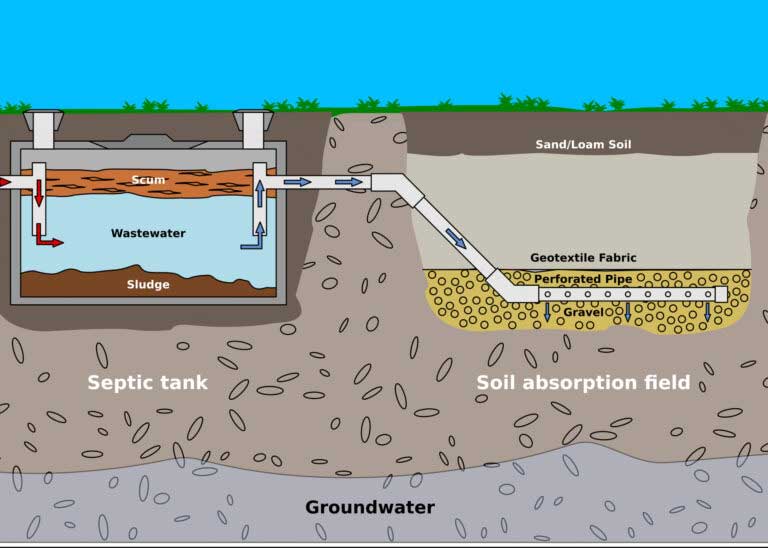A marvel of modern technology, septic systems allows us to enjoy the convenience of indoor plumbing without the worry of how to dispose of our household waste in an efficient and safe way.
But do you really know how your septic system works?
Understanding the way your septic system operates is key to ensuring that it is properly utilized and maintained.
Read on to learn more about what your septic system is and how it functions:
Common Parts of a Septic System
A septic system is not necessarily a complex system and each of its components work together to make sure your household’s waste is properly stored and disposed of.
Septic Tank
The septic tank is a large rectangular or cylindrical container made of concrete, fiberglass or polyethylene that is buried under the ground on your property.
These onsite sewage facilities are used for properties that are not connected to a sewer system and most commonly found in rural areas.
Drainfield
Sewage from the septic tank flows through pipes into your yard through the drainfield. Wastewater is typically stored in the septic tank for two days before being released to the drainfield.
This part of your septic system involves long pieces of pipe, called “drainpipes”, that feature small holes that allow for this release.
Drainfields can become potentially blocked if solids build up and are not pumped out properly. These blockages can be caused by an undersized septic tank, infrequent pumping of the septic tank and high volumes of water.
Your drainfield may be blocked if you notice:
- Greener grass over the drainfield
- Strange odors in your yard
- Plumbing backups
- Wet or mushy ground
If your drainfield is blocked, your entire septic system will not function properly. It is best to call in professional underground service technicians to alleviate the issue.
Pump Tanks
While pump tanks are not a necessary component of your septic system, they are recommended to ensure the proper operation and maintenance of the system.
Pump tanks contain the following:
- Effluents pump. Catches solids before they leave the tank to prevent them from being released into the drainfield to prevent clogging of the drainfield.
- Control floats. Connected to a control panel and signal when to turn the pump off and on
- High-water alarm. Activates if the pump fails to work to indicate high volume in the septic tank. Typically located under the kitchen sink or in the garage.
If the high-water alarm is activated, it is best for homeowners to conserve water and have an expert septic system technician to inspect the water levels.
Distribution Box
The distribution box is located between the septic tank and the drainfield and is designed to evenly distribute wastewater equally between the drainfield lines.
Leach Drain Field
The leach field, or septic field, is a part of your septic system that receives the effluent from the septic tank.
It refers to the network of drainpipes, stones and a layer of unsaturated soil. It distributes waste into the soil which then eventually returns to the water table.
How a Septic System Works
Together, all of these components work to eliminate wastewater from your home and safely distribute it into the ground.
It does this by relying on naturally occurring bacteria to break down the materials that are deposited into the septic tank.
Whatever substances you flush down your toilet or rinse down your drains divides into three categories:
- Sludge: Refers to heavy materials (such as solid food waste, feces and toilet paper) that settle on the bottom of the tank. Over time, natural bacteria break down the solids until they can be pumped out of the tank.
- Scum. These are lighter materials (soaps, oils, grease) that float to the surface of the septic tank.
- Liquid (Effluent) Wastewater. This remaining water sits in the middle of the tank and is moved to the drainfield.
Everything deposited into your septic tank will eventually become effluent wastewater and exit the tank into the drainfield.
This pretreated (due to the bacteria) wastewater is discharged through the drain pipes and is filtered through the soil. The soil then absorbs, treats and disperses the wastewater until it eventually seeps to groundwater.
The soil naturally removes harmful bacteria and viruses as well as absorbs nutrients.
Septic System Issues
As we mentioned above, septic systems can experience high water levels as well as blocked drainfields.
However, there are other septic-related issues you should keep in mind:
- Clogs. Apart from blockages in the drainage pipes, the system can become clogged between your home and the tank. You’ll notice slow drainage or sewage backups in your home.
- Tree roots. Tree roots will naturally grow toward water and moisture and tend to wrap around or bore through obstacles in their way. If there are trees growing on or around your septic system, they may cause damage to the tank or pipes.
- Detergent products. Certain detergent products that contain high levels of phosphate can encourage the growth of algae in your tank which can then block the perforations within the drain pipes.
In order to prevent issues with your septic system, it is best to be mindful of the substances and items you are releasing into your home’s plumbing.
Try to use detergents and cleaners that are designed for septic systems and low in phosphates. These products break down more easily and will prevent your system from becoming clogged.
Also, be aware of what is being flushed down the toilet. Paper towels, sanitary tampons and anything plastic and non-biodegradable are not designed to break down in the septic tank.
Food scraps, coffee grinds and other food items will also compromise your septic system’s functions.
Regular pumping and maintenance is a sure way to help your septic system work at peak performance.
To have your septic system expertly serviced, or repaired, please contact Peak Sewer & Underground Services – we are available 24/7 to answer your questions and address your concerns!

